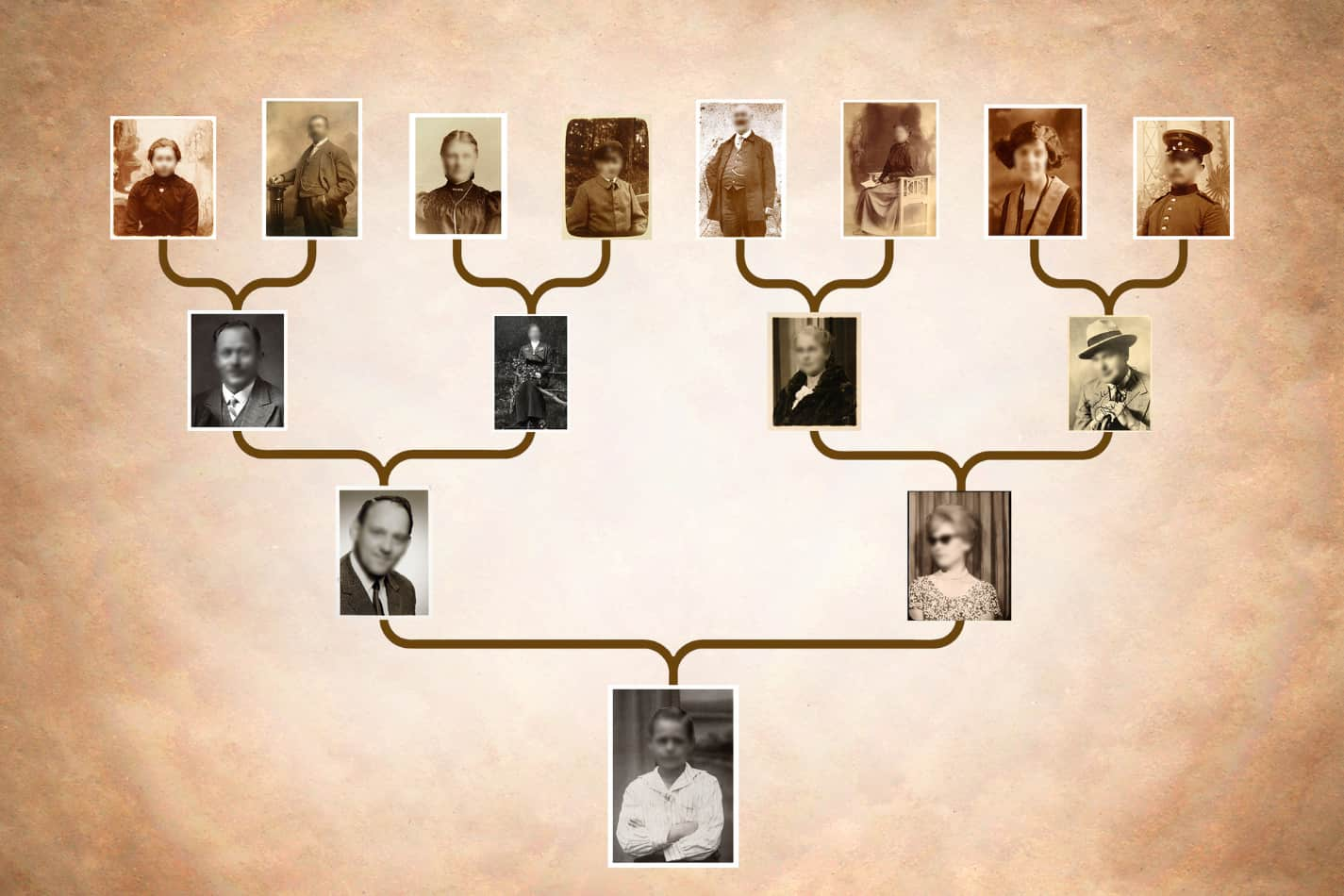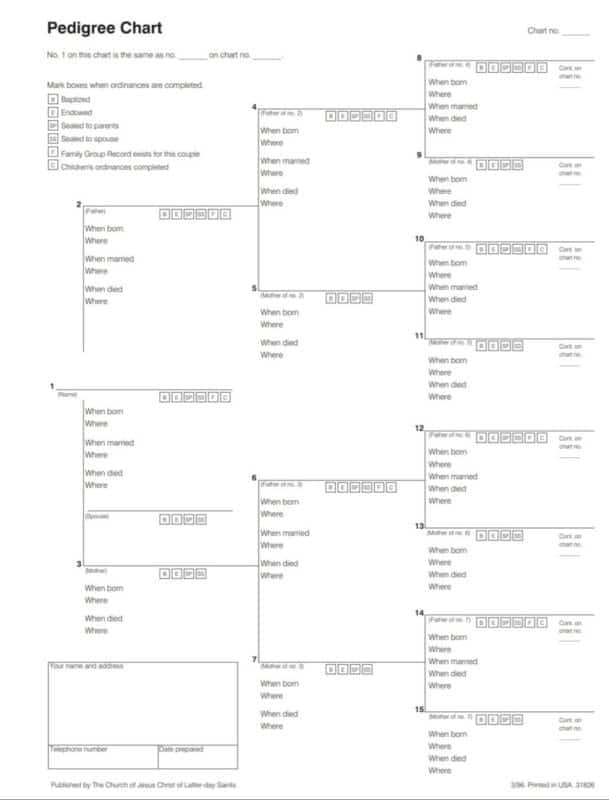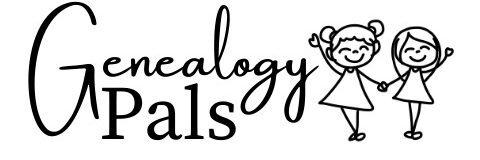There are an awful lot of new terms when doing genealogy to learn. And one of those new vocabulary words is a pedigree chart. But what is a pedigree chart in genealogy? And what do I need to know about it right now?
A pedigree chart in genealogy is a diagram used to visualize the direct lineage in your family tree. Simpler pedigree charts only show parent-child relationships while more elaborate ones may include dates and places. Pedigree charts can vary widely in look and design, depending on the template used.
Keep reading to learn more about pedigree charts in genealogy – and to see examples of pedigree chart styles commonly used!

What is a Pedigree Chart?
A pedigree chart is a form that tracks family lineage or lines of descent. Usually, it’s a very visual diagram, with lines connecting parents to their children.
There are different levels of pedigree charts – some are simpler and only use names. Others are more elaborate and include important family dates, locations, and other information.
A pedigree chart can track any family descent (and ancestry) and is not just for humans. Pedigree charts are often used for animals, especially if they are actively involved in shows, breeding, or some type of sport. Animals that commonly have pedigrees tracked are dogs, horses, and some breeds of cats.
So whether you’re tracking your family history (or doing research on an animal’s lineage), you’re probably going to be using a pedigree chart.
But before we go on, let’s take a look at the etymology of the term – because it’s nerdy and fun to know where a word comes from.
Pedigree comes from an Anglo-French word that means the foot of a crane. Apparently, a long time ago people thought that these charts looked like the foot of a crane.

I can almost see how they could draw that connection… But yeah – it’s not what I would have called it, either. Oh well. That’s where the name comes from, so that’s fine. And at least the visual should help you remember its etymology and meaning. It helped me, anyway.
Oh, and while the example image above does use a vertical style of pedigree chart, many actually orient the other direction – horizontally. Both styles are common. The image I used above just helped make the crane’s foot connection more obvious – at least to me.
Okay, so that’s what it is. What does a pedigree chart look like?
What Pedigree Charts Look Like
Pedigree charts usually either come in a landscape (horizontal) or portrait (vertical) view. Both styles are common enough that they’re easily recognized and accepted, so go ahead and choose whichever you like best.

Once you can read and fill in one style, the other becomes easy, too. So don’t worry about that.
From there, your pedigree chart will look like this. Find the spot labeled #1 – that’s going to be you. The even numbers will be the men – and spot #2 will be your father. The odd numbers are the women, so #3 will be your mother.
While we could sure debate about the reasoning, fairness, and history of assigning numbers to genders, that’s not really the point of this article. Rather, it’s to point out that there is a system in place. And it’ll be easier to understand and read future pedigree charts if you know the system. Even if it grates on you.
As you keep reading to the right (or up/down, depending on your pedigree chart’s orientation), you’ll find spaces for other family members.
Below everyone’s names are spaces for the most basic, important dates and places – such as birth, marriage, and death.
Where Can I Download a Free Pedigree Chart?
Here are two commonly-used pedigree charts you can download right now for free. And a third free option that comes with a lot of cool bonuses. 😀
- Get a free online, editable PDF 6-generation pedigree chart from Misbach that has space (and prompts) for birth, birthplace, marriage date and place, death date, and location. This PDF also has spaces for you to list your children. Just don’t forget to save that PDF (and print it!) before you close the tab. You may also want to print (or save) a few blank copies of it for later.
- Get a free online 4-generation family pedigree chart from FamilySearch.org that also has space (and prompts) for birth, birthplace, marriage date, death date, and where they died. This PDF is not editable but it does have spots to keep track of ordinances and is perfect for members of the Church of Jesus Christ. However, it can be used by anyone – simply ignore the ordinance information.
- Get access to all of our GenealogyPals forms and downloads, including a free pedigree chart, via our subscriber’s library. It’s exclusively available to newsletter subscribers – but that’s totally free, too. So feel free to subscribe and download all the forms you want. The sign-up form is at the bottom of this article.
Those are just our favorite charts. There are plenty of them available with a quick Google or Pinterest search. However, a word of caution – it’s easy to get sucked into the idea that you can find and download the “perfect” pedigree chart.
It’s far better to get started with what you’ve got. So if you’re in doubt about which pedigree chart to download, grab one of the free ones above and get going. You can always go back later – but if you keep delaying starting your genealogy, you can’t ever get that lost time back.
Where Can I Keep and Track My Pedigree Chart Online?
For those of you who prefer to go paperless (I’m with you!), you can do all of your genealogy research and pedigree-chart-filling-out online if that’s your preference. Your favorite genealogy website will have online pedigree charts for you to fill out. They’re even printable in case you do need a paper copy.
Or you could just pull up your pedigree on their app – or a regular browser tab on your phone. Their sites are mobile-friendly.
So if you’d prefer to go paperless, that’s a solid option – and you can read more about the best genealogy websites (including some free ones) right here.
Who Uses Pedigree Charts
Anyone interested in their family or lineage can use a pedigree chart. However, genealogists are probably the most famous for using pedigree charts to keep track of family relationships.
Anyone interested in genetics (including medical professionals, scientists, and genetic genealogists) would also use a pedigree chart. In this case, it may help track how genetic traits are inherited through a family. To read more about genetic genealogy, read our post on it here.
In the case of animal pedigree charts, breeders also use pedigree charts to guide their stock toward desired traits and characteristics. Zoos may also track pedigree charts, especially if they are actively involved in any breeding programs for endangered or protected species.
When to Use a Pedigree Chart
Pedigree charts are perfect to visualize family information and lineage over multiple generations. If you’re trying to see how a family looks, which kids belonged to which parents or somebody’s ancestry (or line of descent), a pedigree chart is the fastest and easiest way to see things in an easy-to-follow manner.
It’s also just a great way to see basic family information (across several generations, if needed) on the same page.
In fact, it’s probably the best method to look up general family information in most situations. When you’re wanting specific individual information, even then you can still get most of it from a pedigree chart. But if you want a super-specific detail, that’s when you’ll switch from the pedigree chart to an individual or family group sheet record.
So if you’re wanting to store, access, or look at family information and relationships, you’re going to want to use a pedigree chart. There are a lot of template options, though, so feel free to find the one that works for you.
Why I Should Use a Pedigree Chart
Keeping track of family gets overwhelming fast. Using a pedigree chart helps you keep things organized easily and quickly by generation. Plus, a pedigree chart then also helps you with the visualization of family relationships.
For individuals and specific families, you’ll probably also want to create individual and family group records. That way, you can store additional information that doesn’t fit on the pedigree chart, like other siblings and their vital information.
Again, there are a lot of pedigree templates out there. So now that you’ve got you why find a template that works for you and start recording your genealogy?
Can I Make My Own Pedigree Chart?
Absolutely! Depending on what you intend by the word “make”, though, there are several options.
If by “make” you mean that you want to download a ready-made template and fill it out, we’ve got you covered. Just scroll up to the earlier part of the article where we list 3 of our favorite pedigree chart templates. All three are free to download. Or if you’d rather not scroll, click here to see our favorite download options.
Or if you meant you’d like to make your own template for your pedigree chart, that’s an option, too. I recommend using something like Canva, PowerPoint (or Google Slides), or even a simple Word (Google Docs) to make something that will work for your family.
Remember – it doesn’t have to be fancy. So start simple. You can always make it fancier later on.
And if you decide that making your own template is too complicated? Don’t stress. It is complicated to make a simple-looking template. It’s easy to get bogged down in all the details. It’s okay to try it again later. Just download a template for now and get going on your genealogy. It’s better to keep going than to get crazy frustrated.
Once you’ve got your form, go ahead and start filling it out.
How Do I Fill Out a Pedigree Chart?
Filling out a pedigree chart can be as easy or involved as you want to make it. It’s going to depend on how much information you want to be stored on it, really.
- Start by choosing a pedigree chart template. Refer back to the earlier section in this article about where you can find free pedigree charts to choose the style that most appeals to you.
- The usual information on a pedigree chart is name, birthdate and location, marriage and location, death date and location, parents, and child/children.
- Write down the names, dates, and location information that you know and you can prove with vital records (like birth, death, and marriage certificates or other public records like the census). Write them in the appropriate and provided lines on the pedigree chart.
- Fill in the holes by asking family members.
- Verify any information by finding the appropriate record to serve as a validating source or citation.
- Find new records (check online sites like FamilySearch.org and Ancestry.com for digitized records) to fill in any blanks.
- Remember to cite those sources! Cite them online, on the paper pedigree chart, or where ever else is appropriate.
- Look over your pedigree chart and bask in the success of a job well done.
From there, there could be another step or two. They’d be these:
- Keep doing more genealogy! Find another relative to talk to about it.
- Become a genealogy pal. Or a genealogy aficionado – either level is totally awesome and appropriate.
In any case, you’ve now got a filled-out pedigree chart – so go celebrate. It’s a solid accomplishment.
The Differences Between Pedigree, Ancestor, and Lineage Charts
Pedigree charts, ancestor charts, and lineage charts are synonyms for the same thing. So if you’ve got a preferred term, use it. Just be sure to let the rest of us know (or remind us if it’s an off day) what you mean if we give you a blank stare.
What Type of Information Makes a Pedigree Different from a Family Tree?
Pedigree charts and family trees are, generally speaking, the same thing. Hooray for synonyms, right?
In some instances, though, a family tree may include more siblings, cousins, aunts and uncles, and other family members than you’d usually see on a pedigree chart. This may especially be the case if the family tree only shows 1-2 generations.
For example, one of my kids came home with a 3-generation family tree from church one week. It left off their great-grandparents, so it instead made more space for extended families and cousins and such. An 8.5″x11″ piece of paper can only hold so much information, after all. Especially if there’s a cool chart on there to guide how the information gets added.
Both terms (pedigree and family tree) are generally similar, even if the forms can vary widely.
What is a Genealogy Chart?
A genealogy chart is any which shows family relations. Most often, this refers to a pedigree chart.
However, some individuals have created fancy genealogy charts that use spreadsheets, tables, or other chart styles to show relationships. These aren’t as commonly used, though, and can be harder for most of us to read.
So in most cases, just consider a genealogy chart as yet another synonym of a pedigree chart.
What is a 4-Generation Pedigree Chart?
A 4 generation pedigree chart means that it’s a pedigree or family history tree that shows four generations. This means it shows you, your parents, your grandparents, and your great-grandparents. For human-based genealogy, a 4 generation pedigree chart is usually the smallest chart made.
Isn’t it fun that pedigree charts can be customized to show as much or as little of your family history as you want?
Related Questions
How do you fill out a pedigree chart? Pedigree charts will have space to fill out specific information. Each space will typically have a prompt with what information goes into the provided space. Simply write in the prompted information to fill out a pedigree chart. If no prompts are provided, finding a new and easier-to-use pedigree chart may be best.
What is a 3-generation pedigree? A 3 generation pedigree lists all of the ancestors in the family tree for three generations. This specific term is most usually for animals and events like dog shows. However, some people like to start by finding their 3 generation pedigree chart which would include themselves, their parents, and their grandparents.
Where can I find free genealogy forms and charts for an individual? There are countless free genealogy forms, templates, and charts available online. The best free website, FamilySearch.org, is a great resource for free genealogy forms. Or, if you’d like to skip setting up an account, you can get access to our entire library of free genealogy forms by subscribing to our newsletter.
To subscribe, simply fill out the form at the bottom of this post. Subscribing, downloading everything you want, and unsubscribing is a valid option should you prefer not to get awesome emails. But really – the emails are pretty awesome, so we think you’ll want them. 🙂
Get Genealogy and Family History News and Tips in Your Inbox.
Any time there’s a cool update to the world of genealogy, you’ll get an email with our explanation of it – and information on how you can implement the latest and greatest evidence-based research and practices in your family history. We only send emails a few times a year.
It’s free to get cool stories, updates, news, and more. Subscribers get exclusive access to cool extras and downloadable files via the subscriber-exclusive library.
Join the Genealogy Pals newsletter community!
We use SendFox as our email marketing platform. By clicking to submit this form, you acknowledge that the information you provided will be transferred to SendFox for processing per their terms of use.
Want a sneak peek at some of what’s in the subscriber-exclusive library? Check it out here.
Resources
When learning about genealogy, it’s important to learn from various reputable sources. These are the sources used in this article and our research to be more informed as genealogists.
- “Pedigree.” Dictionary.com, Dictionary.com, www.dictionary.com/browse/pedigree.
